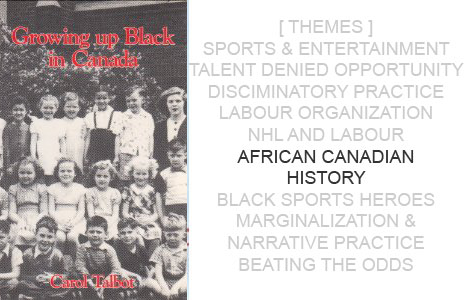A Little Folk Geography
Materials:
Growing Up Black in Canada, Chapter 2, “A Little Folk Geography”; esp. map page 18
See also for neighbourhood exploration: http://janeswalk.net/index.php/which-user/school
http://www.yorku.ca/acc/lesson_plan7.html
Lesson:
Students will consider their neighbourhoods from a variety of spatial, visual, auditory, social and material perspectives.
1. Read the chapter. Why does Talbot call her map a “mental map”? What do you think it expresses? For example, what places does she mark? What do her markings tell you about her?
How is a “mental map” different from another kind of map; for example, a street plan, an aerial map, etc. ?
2. Consider some questions about your neighbourhood.
Is there a “hang out” in your neighbourhood?
A park, a café, a store
where can you see a gathering of your neighbours?
how often do people go there? why?
Where is the centre of your neighbourhood? Why do you consider it the centre?
Define the lines around where it feels like “your neighbourhood.” What makes it feel that way?
What are the visible and invisible lines that divide up your neighbourhood?
A road, another school, a parking lot
3. Create a sound map of your neighbourhood.
Collect 10 different sound samples from around your neighbourhood. Be sure to take note of the exact place, exact time, weather, season, and exactly what sounds can be heard in your recording.
Could similar maps be created for other senses? Taste: collect restaurant cards, list all the foods that can be bought in your neighbourhood, create a collage.
4. As a class, find creative ways to map a park near you.
Why is the park named what it is?
What insects can be found where?
What (observed) activities are performed where?
Create a graph of who comes into the park; e.g. women with strollers, old men with large dogs
Where are the fences and why are they up?
As a class, find creative ways to map your school grounds.
Microscopically, by grade, by season, by altitude (good math exercise!), with only colours, with sound
5. Investigate the name of a street/local library/community centre.
What’s the history behind the name?
Why did your community decide to name that ________ after it?
6. Map different spaces in your neighbourhood. Do a profile of two opposites.
Quiet/loud, private/public, free/have to pay, active/relaxing
7. Copy all the signage in a shop window. Analyze them. What messages does the store want to give a passer-by?

